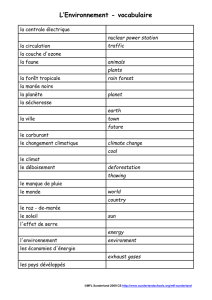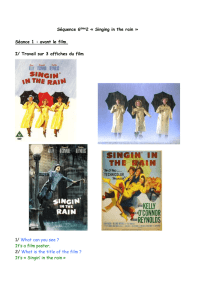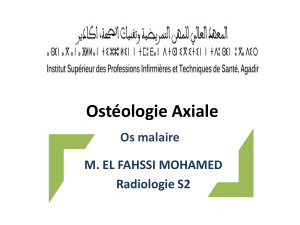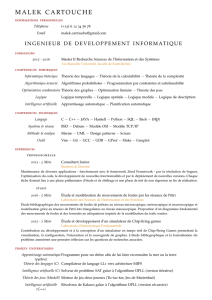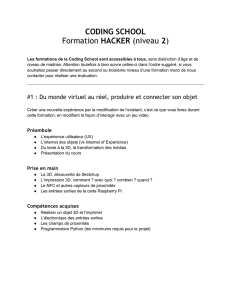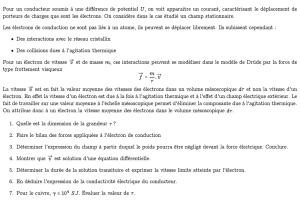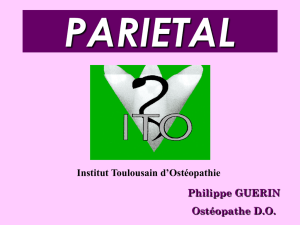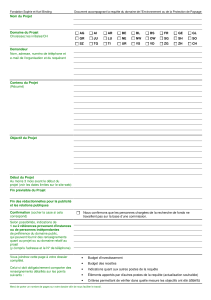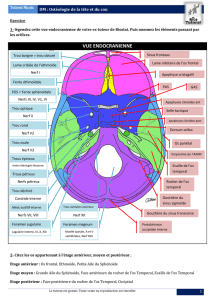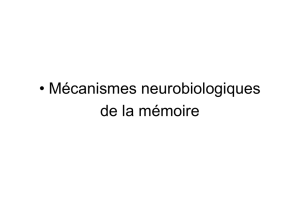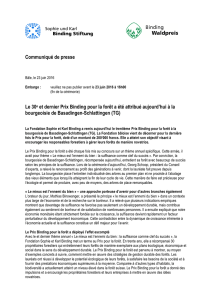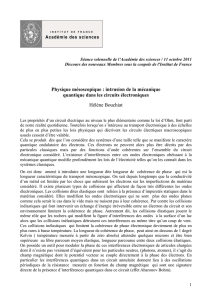Tapestries, Ponds and RAIN
publicité
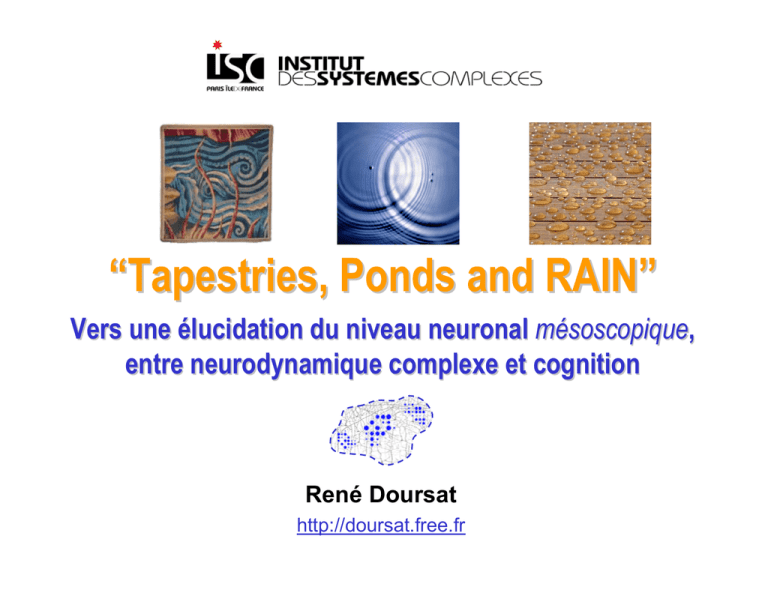
“Tapestries, Ponds and RAIN” Vers une élucidation du niveau neuronal mésoscopique, entre neurodynamique complexe et cognition René Doursat http://doursat.free.fr Entre neurodynamique complexe et cognition 1. Vers une science cognitive unifiée Des neurones aux symboles : le niveau mésoscopique manquant 2. L’importance du codage temporel Le “binding problem” et les représentations structurées 3. Le cerveau comme machine morphogénétique Des objets endogènes façonnables, stimulables et composables 4. Le paradigme émergent des systèmes complexes Connectivité récurrente, activité spontanée, compositionalité 5. Trois études mésoscopiques “Tapestry, ponds and RAIN” : synfire chains, ondes et résonance 2 L’état des sciences cognitives et de l’I.A. ¾ I.A. : symboles, syntaxe → règles de production 9 les systèmes logiques définissent des symboles de haut niveau qui peuvent être composés de façon générative → il leur manque une “microstructure” fine, nécessaire pour expliquer la catégorisation floue en perception, contrôle moteur, apprentissage, etc. ¾ Chaînon manquant : niveau de description “mésoscopique” 9 les phénomènes cognitifs émergent de la neurodynamique complexe sous-jacente, par l’intermédiaire de motifs spatio-temporels structurés ¾ Réseaux de neurones : nœuds, liens → règles d’activation 9 dans les systèmes dynamiques neuro-inspirés, les nœuds d’un réseau s’activent mutuellement par association → il leur manque une “macrostructure”, nécessaire pour expliquer la compositionalité systématique du langage, du raisonnement, de la cognition 3 L’état des sciences naturelles au XIXème siècle niveau macro : lois génétiques × TT × Tt × → Tt × Tt → TT, Tt, tT, tt niveau micro : atomes 4 L’état des sciences naturelles au XXème siècle niveau macro : × TT × Tt × → Tt × Tt → TT, Tt, tT, tt biologie moléc. niveau méso : lois génétiques niveau micro : atomes → système complexe multi-échelle 5 L’état des sciences cognitives au XXème siècle niveau macro : symboles “John donne un livre à Mary” → “Mary possède le livre” niveau micro : neurones 6 L’état des sciences cognitives au XXIème siècle? “cognition moléc.” Mary donG ner John niveau méso : symboles “John donne un livre à Mary” R → G h Jo O bal le oirO av P n G ner do n O R ry Ma r donne re liv O R avoir P O “Mary possède le livre” ba lle livre niveau macro : John Mary niveau micro : neurones → système complexe multi-échelle 7 Vers une science cognitive unifiée ¾ Pour expliquer des phénomènes macroscopiques à partir d’éléments microscopiques, des structures mésoscopiques sont nécessaires 9 pour expliquer et prédire les règles symboliques de la génétique à partir des atomes, la biologie moléculaire est nécessaire 9 de même, pour expliquer et prédire les règles symboliques du langage et de la perception (catégorisation, hiérarchie, inférence, composition) à partir des activités neuronales, une “cognition mésoscopique” est nécessaire ¾ Que pourraient donc être les “objets” d’une future science cognitive unifiée ? 8 Niveau mésoscopique de champs moyens ¾ Peupler le niveau mésoscopique (1) : modèles de champs “bumps”, “blobs”, bulles méso-niveau de champs moyens EEGs spatiaux, attracteurs chaotiques ¾ Chaînon manquant : niveau de description “mésoscopique” Freeman (1994) les « formes » de l’esprit, c.a.d. Amari (1975, 9 Caractériser de1977) la neuronalecaractérisés par des variables de champ 9 dynamique ensembles neuronaux moyen, continues dans le temps et/ou l’espace, par ex. : local field potentials fréquences de décharge (densités de spikes) densités de neurotransmetteurs, etc. 9 Niveau mésoscopique de spikes ¾ Peupler le niveau mésoscopique (2) : modèles à spikes méso-niveau de spikes 9 assemblées de cellules larges mais locales, présentant des régimes (digitaux-analogiques) complexes et reproductibles d’activité neuronale → motifs spatio-temporels (“spatiotemporal patterns”, STPs) structurés et modulaires, à une échelle fine BlueColumn (BlueBrain) groupes polychrones ... Markram (2006) Izhikevich (2006) 10 Niveau mésoscopique de spikes ¾ Peupler le niveau mésoscopique (2) : modèles à spikes 9 assemblées de cellules larges mais locales, présentant des régimes (digitaux-analogiques) complexes et reproductibles d’activité neuronale → motifs spatio-temporels (“spatiotemporal patterns”, STPs) structurés et modulaires, à une échelle fine méso-niveau de spikes tapestries “synfire chains” et tresses Abeles (1982), Doursat (1991), Bienenstock (1995), D & B (2006) ponds ondes morphodynamiques RAIN résonance “clé-serrure” 3200 EXC Doursat & Petitot (1997, 2005) 800 INH Vogels & Abbott (2006) Doursat & Goodman (2006) 11 Entre neurodynamique complexe et cognition 1. Vers une science cognitive unifiée Des neurones aux symboles : le niveau mésoscopique manquant 2. L’importance du codage temporel Le “binding problem” et les représentations structurées 3. Le cerveau comme machine morphogénétique Des objets endogènes façonnables, stimulables et composables 4. Le paradigme émergent des systèmes complexes Connectivité récurrente, activité spontanée, compositionalité 5. Trois études mésoscopiques “Tapestry, ponds and RAIN” : synfire chains, ondes et résonance 12 Temporal coding vs. rate coding ¾ There is more to neural signals than mean activity rates 9 rate coding: average spike frequency 9 temporal coding: spike correlations not necessarily oscillatory possibly delayed 13 Temporal coding vs. rate coding ¾ Below mean firing-rate coding: precise temporal coding 9 more than mean rates → temporal correlations among spikes high activity rate rate coding high activity rate high activity rate low activity rate low activity rate low activity rate temporal coding ¾ zero-delays: synchrony (1 and 2 more in sync than 1 and 3) ¾ nonzero delays: rhythms (4, 5 and 6 correlated through delays) 14 Temporal coding vs. rate coding ¾ Historical motivation for rate coding – Adrian (1926): the firing rate of mechanoreceptor neurons in frog leg is proportional to the stretch applied – Hubel & Wiesel (1959): selective response of visual cells; e.g., the firing rate is a function of edge orientation → rate coding is confirmed in sensory system and primary cortical areas, however increasingly considered insufficient for integrating the information ¾ Modern temporal coding “boom”: a few milestones – von der Malsburg (1981): theoretical proposal to consider correlations – Abeles (1982, 1991): precise, reproducible spatiotemporal spike rhythms, named “synfire chains” – Gray & Singer (1989): stimulus-dependent synchronization of oscillations in monkey visual cortex – O’Keefe & Recce (1993): phase coding in rat hippocampus supporting spatial location information – Bialek & Rieke (1996, 1997): in H1 neuron of fly, spike timing conveys information about time-dependent input 15 Binding with Temporal Code ¾ The “binding problem” 9 how to represent relationships? feature cells stimulus or concept = = = = 16 Binding with Temporal Code ¾ More generallly: feature binding in cell assemblies 9 unstructured lists or “sets” of features lead to the “superposition catastrophe” soft big corners + blue = hard green small 17 Binding with Temporal Code ¾ “Grandmother” cells? ... ... ... ... ... + = ... → one way to solve the confusion: introduce overarching complex detector cells 18 Binding with Temporal Code ¾ “Grandmother” cells? ... ... ... ... . . . however, this soon leads to an unacceptable combinatorial explosion! 19 Binding with Temporal Code ¾ Relational representation: graph format 9 a better way to solve the confusion: represent relational information with graphs + = 20 Binding with Temporal Code ¾ Idea: relational information can be encoded temporally! 9 back to the binding problem: a solution using temporal coding feature cells stimulus or concept = grandmother cells = = = = = after von der Malsburg (1981, 1987) 21 Binding with Temporal Code ¾ Molecular metaphor: spatiotemporal patterns “cognitive isomers” made of the same atomic features C3H8O 1-propanol 2-propanol 22 Binding with Temporal Code ¾ Problems of compositionality again⎯in language John lamp see book give car talk Rex Mary (a) John gives a book to Mary. (b) Mary gives a book to John. (c)* Book John Mary give. 23 Binding with Temporal Code ¾ Problems of compositionality again⎯in language John S book O give R Mary 24 Binding with Temporal Code ¾ Problems of compositionality again⎯in language 9 language is a construction game of “building blocks” John John S give book O S O give R book R Mary Mary 25 Binding with Temporal Code ¾ Problems of compositionality again⎯in language 9 language is a construction game of “building blocks” John S O give book R Mary 26 Binding with Temporal Code ¾ A building-block game of language Mary book G O give John ba ll R 9 the “blocks” are elementary representations (linguistic, perceptive, motor) that assemble dynamically via temporal binding John G O book give R Mary y Mar 9 representations possess an internal spatiotemporal structure at all levels G O give ball R hn Jo after Bienenstock (1995) after Shastri & Ajjanagadde (1993) 27 Binding with Temporal Code ¾ Problems of compositionality again⎯in vision 28 Entre neurodynamique complexe et cognition 1. Vers une science cognitive unifiée Des neurones aux symboles : le niveau mésoscopique manquant 2. L’importance du codage temporel Le “binding problem” et les représentations structurées 3. Le cerveau comme machine morphogénétique Des objets endogènes façonnables, stimulables et composables 4. Le paradigme émergent des systèmes complexes Connectivité récurrente, activité spontanée, compositionalité 5. Trois études mésoscopiques “Tapestry, ponds and RAIN” : synfire chains, ondes et résonance 29 Vers une neurodynamique mésoscopique fine ¾ La richesse dynamique des motifs spatiotemporels 9 des assemblées neuronales dynamiques produisant des régimes complexes d’activité reproductibles neurodynamique mésoscopique fine 9 ces régimes d’activité sont soutenus par une connectivité récurrente (plus ou moins) spécifique et ordonnée 9 HYPOTHESE : le cerveau comme machine à formation de motifs spatiotemporels: STP (SpatioTemporal Patterns) 30 Formation de motifs ¾ Le développement biologique est affaire de motifs .... en quoi le cerveau serait-il différent? ocular dominance stripes Hubel & Wiesel, 1970 cartes de connexions, rayures fonctionnelles, etc. orientation column “pinwheels” Blasdel, 1992 Scott Camazine, http://www.scottcamazine.com 9 motifs du manteau épithélial, chromatophores, etc. 31 Model of dog heart 9 motifs dynamiques fonctionnels Olfactory bulb phase Spontaneous Chicken retina waves pattern W. Freeman VC activity Grinvald Gorelova & Bures, 1983 J. Keener, University of Utah Aggregating slime mold B. Goodwin, Schumacher College, UK Formation de motifs ¾ La physiologie multicellulaire est aussi affaire de motifs .... en quoi le cerveau serait-il différent? blobs d’activité, ondes progressives, etc. 32 Systems that are self-organized and architectured free self-organization the engineering challenge of complicated systems: how can they integrate selforganization? Peugeot Picasso the scientific challenge of complex systems: how can they exhibit a true architecture? designed architecture Peugeot Picasso self-organized architecture / architectured self-organization 33 Le cerveau comme machine morphogénétique ¾ Vers des nuages de spikes “architecturés” ? 9 STP non triviales, douées d’une structure ⇔ 34 Entre neurodynamique complexe et cognition 1. Vers une science cognitive unifiée Des neurones aux symboles : le niveau mésoscopique manquant 2. L’importance du codage temporel Le “binding problem” et les représentations structurées 3. Le cerveau comme machine morphogénétique Des objets endogènes façonnables, stimulables et composables 4. Le paradigme émergent des systèmes complexes Connectivité récurrente, activité spontanée, compositionalité 5. Trois études mésoscopiques “Tapestry, ponds and RAIN” : synfire chains, ondes et résonance 35 The litteral informational paradigm sensory neurons motor neurons relays, thalamus, primary areas primary motor cortex 36 The litteral informational paradigm ¾ Questionable engineering metaphor: “signal processing” 9 feed-forward structure − activity literally “moves” from one corner to another, from the input (problem) to the output (solution) 9 activation paradigm − neural layers are initially silent and are literally “activated” by potentials transmitted from external stimuli 9 coarse-grain scale − a few units in a few layers are already capable of performing complex “functions” sensory neurons motor neurons relays, thalamus, primary areas primary motor cortex 37 The emergent dynamical paradigm ¾ New dynamical metaphor: mesoscopic excitable media 9 recurrent structure − activity can “flow” everywhere on a fast time scale, continuously forming new patterns; output is in the patterns 9 perturbation paradigm − dynamical assemblies are already active and only “influenced” by external stimuli and by each other 9 fine-grain scale − myriads of neurons form quasi-continuous media supporting structured pattern formation at multiple scales sensory neurons motor neurons relays, thalamus, primary areas primary motor cortex 38 Entre neurodynamique complexe et cognition 1. Vers une science cognitive unifiée Des neurones aux symboles : le niveau mésoscopique manquant 2. L’importance du codage temporel Le “binding problem” et les représentations structurées 3. Le cerveau comme machine morphogénétique Des objets endogènes façonnables, stimulables et composables 4. Le paradigme émergent des systèmes complexes Connectivité récurrente, activité spontanée, compositionalité 5. Trois études mésoscopiques “Tapestry, ponds and RAIN” : synfire chains, ondes et résonance 39 Vers une neurodynamique complexe 1. Le niveau mésoscopique manquant 2. Trois objets neurodynamiques complexes a. Une tapisserie auto-tressée de synfire chains b. Ondes dans une mare morphodynamique c. Résonance clé-serrure dans des "Recurrent Asynchronous Irregular Networks" (RAIN) 3. Une vue multi-échelle de la causalité neuronale 40 Tapestries a) Une tapisserie auto-tressée de synfire chains → constructing the architecture of STPs Doursat (1991), Bienenstock (1995), Doursat & Bienenstock (2005) 41 Tapestries ¾ What is a synfire chain? 9 a synfire chain (Abeles 1982) is a sequence of synchronous neuron groups P0 → P1 → P2 ... linked by feedfoward connections that can support the propagation of waves of activity (action potentials) P0(t) P3(t) P2(t) 9 synfire chains have been hypothesized to explain neurophysiological recordings containing statistically significant delayed correlations 9 the redundant divergent/convergent connectivity of synfire chains can preserve accurately synchronized action potentials, even under noise 42 Tapestries ¾ Synfire patterns can bind, thus support compositionality hemoglobin 9 cognitive compositions could be analogous to conformational interactions among proteins... 9 in which the basic “peptidic” elements could be synfire chain or braid structures supporting traveling waves 9 two synfires can bind by synchronization through coupling links → molecular metaphor after Bienenstock (1995) and Doursat (1991) 43 Tapestries ¾ A model of synfire growth: tuning connectivity by activity 9 development akin to the epigenetic structuration of cortical maps focusing of innervation in the retinotopic projection after Willshaw & von der Malsburg (1976) 9 in an initially broad and diffuse (immature) connectivity, some synaptic contacts are reinforced (selected) to the detriment of others 1. Hebbian rule ΔWij ~ xi xj ∑ ΔWij ~ 0 2. sum rule “selective stabilization” by activity/connectivity feedback after Changeux & Danchin (1976) 44 Tapestries ¾ Synfire chains develop recursively, adding groups 1 by 1 ΔWij ~ xi xj ∑ ΔWij ~ 0 network structuration by accretive synfire growth t = 200 t = 4000 spatially rearranged view . . . . 45 Tapestries ¾ Sync & coalescence in a self-woven tapestry of chains 9 multiple chains can “crystallize” from intrinsic “inhomogeneities” in the form of “seed” groups of synchronized neurons cortical structuration by “crystallization” composition by synfire wave binding see Bienenstock (1995), Abeles, Hayon & Lehmann (2004), Trengrove (2005) 9 concurrent chain development defines a mesoscopic scale of neural organization, at a finer granularity than macroscopic AI symbols but higher complexity than microscopic neural potentials 9 dynamical binding & coalescence of multiple synfire waves on this medium provides the basis for compositionality and learning 46 Ponds b) Ondes dans une mare morphodynamique → STPs envisionned as excitable media, at criticality Doursat & Petitot (1997, 2005) 47 Ponds ¾ Linguistic categories: the emergence of a symbolic level 9 we can map an infinite continuum of scenes to a few spatial labels ACROSS IN → how are these transforms perception → language accomplished continuous → discrete by the brain? physical, dynamical → symbolic, logic ABOVE 48 Embodied . . . computation? → α γ β schematization + categorization = drastic reduction of information ¾ The loss of a huge amount of physical / dynamical / morphological details in order to produce a few discrete / symbolic units of knowledge corresponds to schematization and categorization. 49 Ponds ¾ The path to invariance: drastic morphological transforms = = 9 what can be compared, however, are virtual structures generated by morphological transforms influence zones influence zones 9 scenes representing the same spatial category are not directly similar ∈ ABOVE ∈ ABOVE 50 Ponds ¾ Proposal: categorizing by morphological neurodynamics 9 discrete symbolic information could emerge in the form of singularities created by pattern formation in a large-scale complex dynamical system (namely, the cortical substrate) (a) (b) (c) “ABOVE” 9 for ex: in traveling waves, singularities are collision points 9 (a) under the influence of an external input, (b) the internal dynamics of the system (c) spontaneously creates singularities that are characteristic of a symbolic category 51 Ponds ¾ Spiking neural networks as excitable media 9 ex: “grass-fire” wave on a lattice of Bonhoeffer-van der Pol units 9 criticality in neural dynamics: when slightly perturbed by an input, the network quickly transitions into a new regime of spatiotemporal order 9 the structure and singularities of this regime are influenced by the input 52 Instead of group synchronization: traveling waves Instead of phase plateaus: phase gradients ϕ ϕ π π x -π Wang, D. L. & Terman, D. (1997) Image segmentation based on oscillatory correlation. Neural Computation, 9: 805-836,1997 x -π Doursat, R., & Petitot, J. (2005b) Dynamical models and cognitive linguistics: Toward an active morphodynamical semantics. To appear in Neural Networks (special issue on IJCNN 2005) 53 Spiking neural model supporting traveling waves Detection of singular points 54 Dynamic evolution of singularities “OUT OF” ¾ The movie-scenario “out of” is revealed by a bifurcation: the singularity (red) disappears as the ball (black) exits the interior of the box; this is a robust phenomenon largely independent from the shape of the actors. 55 Ponds ¾ Summary: key points of the morphodynamic hypothesis 9 input stimuli literally “boil down” to a handful of critical features through the intrinsic pattern formation dynamics of the system 9 these singularities reveal the characteristic “signature” of the stimulus’ category (e.g., the spatial relationship represented by the image) → key idea: spatiotemporal singularities are able to encode a lot of the input’s information in an extremely compact and localized manner 56 RAIN c) Résonance clé-serrure dans des RAIN Networks → pattern recognition by specialized STPs Doursat & Goodman (2006), Goodman, Doursat, Zou et al. (2007) 57 RAIN ¾ Complete sensorimotor loop between cluster and robot 9 original attempt to implement a real-time, embedded neural robot c) a robot (military sentry, industrial assistant, etc.) interacts with environment and humans via sensors & actuators a) NeoCortical Simulator (NCS) software runs on computer cluster; contains the brain architecture for decision-making and learning b) “brainstem” laptop brokers WiFi connection: transmits multimodal sensory signals to NCS; sends actuator commands to robot 58 RAIN ¾ Core of brain model: mesoscopic assemblies as RAINs PFC AV AS MC SC 3200 EXC 800 INH RAIN: Recurrent Asynchronous Irregular Network 59 RAIN ¾ Recurrent Asynchronous Irregular Network (RAIN) Pconnect Gexc 800 excitatory neurons Pconnect Gexc Ginh Pconnect 200 inhibitory neurons Ginh Pconnect extensive domain of selfsustained asynchronous irregular firing R N 60 RAIN ¾ Coherence induction between RAIN networks 9 spatiotemporal pattern “resonance” among ongoing active STPs spikes 9 subnetwork L alone has endogenous modes of activity L K t t 9 by stimulating L, K “engages” (but does not create) L’s modes L t weak coupling K t → the stimulation induces transient coherence & increased activity 61 RAIN ¾ Multi-RAIN discriminate Hebbian/STDP learning (setup) 9 numerical experiment involving 2 RAINs, A and B stimulated by 2 patterns, α and β (RAIN extracts) 1 control RAIN, C (not stimulated) and 1 control pattern γ (not learned) 1 inhibitory pool common to A and B Pattern α 50 EXC 50 EXC Pattern β 50 EXC RAIN A 800 EXC Hebbian learning on the α→A and β→B connections RAIN B RAIN C 800 EXC 200 INH 200 INH 800 EXC 200 INH INH 62 RAIN ¾ Multi-RAIN discriminate Hebbian/STDP learning (results) 9 training phase: alternating α-learning on A and β-learning on B 9 testing phase: A’s (rsp B’s) response to α (rsp β) significantly higher 63 Entre neurodynamique complexe et cognition 1. Vers une science cognitive unifiée Des neurones aux symboles : le niveau mésoscopique manquant 2. L’importance du codage temporel Le “binding problem” et les représentations structurées 3. Le cerveau comme machine morphogénétique Des objets endogènes façonnables, stimulables et composables 4. Le paradigme émergent des systèmes complexes Connectivité récurrente, activité spontanée, compositionalité 5. Trois études mésoscopiques “Tapestry, ponds and RAIN” : synfire chains, ondes et résonance 64
